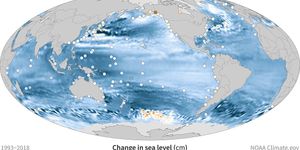Unusual Properties Found in Known Layered Magnetic Crystal
The field of physics has long known about electron “spin waves”, which act like ripples on a pond, but through a magnet. However, a team of researchers recently examined something entirely new called “spin excitons”, which they present in a new study published in Nature Communications. While these new waves also ripple through a magnet, they do so as what’s known as a coherent wave, instead.
Nickel molybdate crystals comprised of two parts nickel, three parts molybdenum and eight parts oxygen (left) and an image of crystal electric field spin excitons from tetrahedral sites in nickel molybdate crystals (right). (Credit: Bin Gao/Rice University)
For the study, the researchers examined a layered magnetic crystal known as nickel molybdate and found it exhibited unusual properties, specifically the electrons within the crystal. Typically, electrons act as like tiny magnets within a crystalline structure, in this case as part of magnetic nickel ions, and discovered that instead of aligning themselves like compass needles, the electrons within the nickel ions essentially canceled each other out, which physicists refer to as a spin singlet.
“Such a substance should not be a magnet at all,” said Dr. Pengcheng Dai, who is a Sam and Helen Worden Professor in the Department of Physics & Astronomy at Rice University, and a co-author on the study. “And if a neutron scatters off a given nickel ion, the excitations should remain local and not propagate through the sample.”
As part of their findings, the researchers observed not one, but two sets of propagating waves, with each exhibiting drastically different energy patterns. To further analyze these patterns, the researchers dived deeper into its mechanisms through what’s known as the crystal field effect, which they conducted through further data analysis and experimentation.
In the end, the researchers found that changes in heat applied to the crystal cause changes in the behavior of the nickel ions within the crystal field environment.
“In one, the field effect is rather weak and corresponds to a thermal energy of about 10 Kelvin,” said Dr. Andriy Nevidomskyy, who is a theoretical physicist at Rice University, and a co-author on the study. “It is perhaps not surprising to see, at few-Kelvin temperatures, that neutrons can excite magnetic spin waves from nickel atoms that are subject to this first type of crystal field effect. But it is most puzzling to see them coming from nickel atoms that are subject to the second type. Those atoms have a tetrahedral arrangement of oxygens around them, and the electric field effect is nearly 20-fold stronger, meaning the excitations are that much harder to create.”
Dr Dai described the magnetic “frustrations” that occur as a result from the magnetic interactions in the triangular lattice formed by the two forms of nickel atoms, with this frustration referring to the challenge of aligning all the magnetic moments occurring between each other. Better understanding these frustrations is what’s behind the longstanding research of Dr. Dai and Dr. Nevidomskyy.
What new discoveries will scientists make about crystal structures and their magnetic properties in the coming years and decades? Only time will tell, and this is why we science!
Sources: Nature Communications, Rice University
As always, keep doing science & keep looking up!









